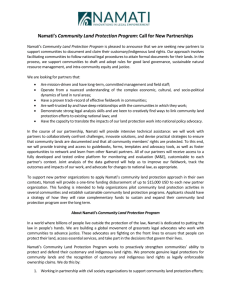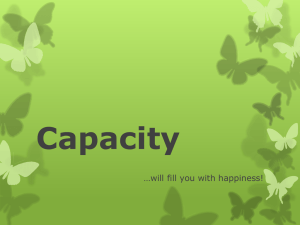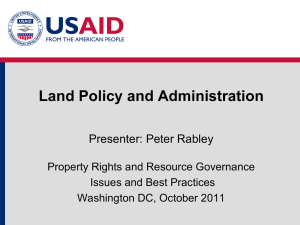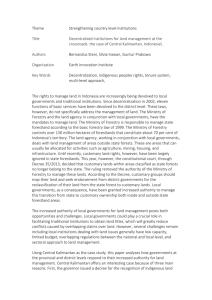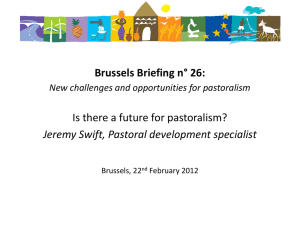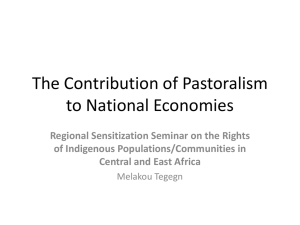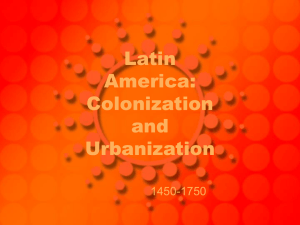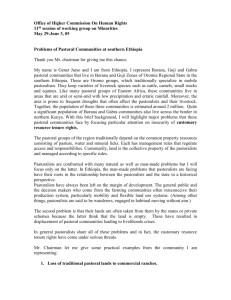Identity & Current Status of Nomadic / Sedentary
advertisement
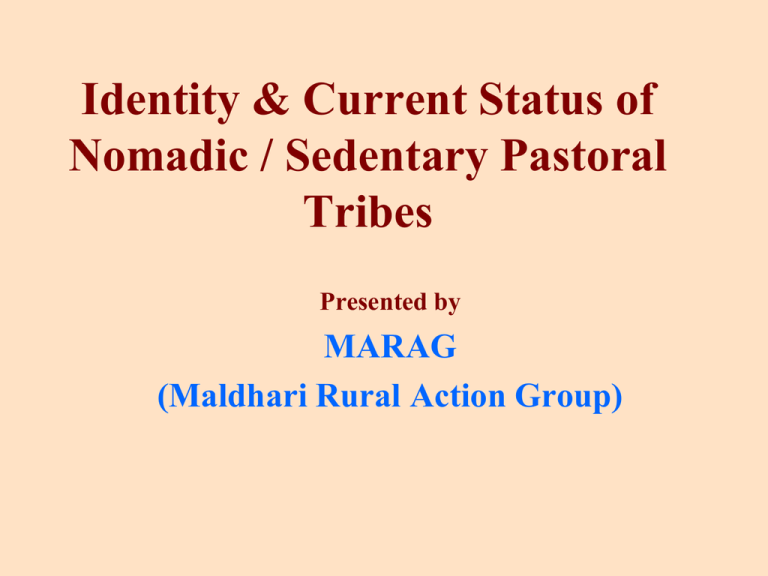
Identity & Current Status of Nomadic / Sedentary Pastoral Tribes Presented by MARAG (Maldhari Rural Action Group) PASTORALISM Pastoralists are people who owe indigenous herd. A community whose main source of livelihood are livestock rearing as a culture and in a traditional way with indigenous knowledge & skills. It also includes those who have been forced out of Pastoralism owing to wrong policies and development model. Living a nomadic life . . . Migration Migration Political Pre Colonial Colonial • Had high important as breeder • Social,economical & physical exploitation started in some kingdom • Close to decision makers due to their indigenous knowledge and skills Lost importance •Exploitation & ignorance at height • Lost interest in governance Post Independence • No where in the political picture • Not a “worthy” community for a politician • State atrocity very high • Out of political or co-operative movement Economical (cont.) Issue • Health Pre-Colonial • Healthy cattle, at times, • Poor health of cattle mass deaths due to due to lack of water & unknown illnesses fodder • Transfer of • Women & Men Had good indigenous knowledge knowledge and skills • Marketing Post-Independence • Milk and other produces were not sold • Only excess produces to • No transfer of indigenous knowledge • Increased sale of row milk Economical Issue • Herd-size Pre-Colonial Post-Independence • More than 100 cows, camels •15 –25 animals • Livestock pattern • Cow>Camel>Goat>Sheep> Buffalo • Grazing practices • Social norms for grazing (when, where, how) • Good and sufficient grazing land • Breeding practices •Sheep>Goat>Buffalo >Cow>Camel • No access and control over CPRs • Degraded and declining grazing land. •Legal Land grabbing • focused on cross • Janada system • Selection of breed, exchange breeds, loss of indigenous breeds of bull Pastoralism Vs Capitalism • • • • • • • • • • Living together Unity Interdependence Common Property Sharing of Knowledge and resources High Ethical values Customary Institutions Gender equity sustainable Concept of conservation • • • • • Nuclear living Highly competitive Dependency/ independent Centralization of property Copy -Pattern rights, • Lack of ethical and moral values • Very strong Patriarchy • Exploitative life style • Just Consume Major problems experienced by the Pastoralists • Non-recognition of Pastoral land rights & Pastoralism -No grazing policy - largest live-stock in the world • Incorrect classification of land use by government • Identity crisis (Ration, electoral card, birth certificate, own village • Livelihood threats - Reduced Pastures - Enclosure of migratory routes - Forests enclosure - Expansion of irrigated agriculture, green revolution - Breakdown of self governance • Forced Sedentary life. • Atrocity against pastoralist (criminal, illegal grazer, antisocial). Major Problems (Cont.) • • • • No access to Govt. services “Non useful” animals Lack of support for input and output market Lack of linkages with outside world and access to information • Urban Pastoralists face severe difficulties as they and their settlement are considered a hurdle in the development of urban areas Pastorlists coming together Pastoral in action • • • • • • • Pastoral Parliament/ PPM Jay Maldhari/Pastoral pride Land right movement Joining hand with other marginalized Policy research-advocacy Strengthening customary institution Direct action to reclaim grazing lands Socio-Cultural (Cont.) Pre Colonial Colonial Post Independence • Dignity of life • Strong ethical values • Women were part of decision making process in customary institution • Traditional Jewelry and clothes showed the richness of culture Lost confidence Degradation of values Women excluded from the formal structure • Lost dignity • Losing ethical values •Women left out of most decision making processes • Traditional practices left behind with modernization Socio-Cultural Pre Colonial • Interdependent • social status • Very strong value based customary leadership (men and women) • Tradition to support others Colonial • beginning of dependence • Declining social status • Decline of customary institution Post Independence • Dependent on others • Lower/No social status • Weakening customary institution, plays very limited role only in sociocultural aspect

